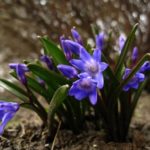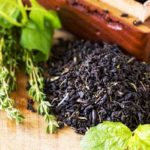Fritillaria (lat.) is the name of a beautiful plant, renamed by the people as hazel grouse. Also, in a simple way, it is often called the “royal crown.” This tall and elegant plant is great for decorating a flower bed or garden. This plant evokes surprise and admiration in every gardener, and its cultivation does not require special skills, since hazel grouse is an unpretentious flower that grows well together with other plants in the garden.
Description of the plant
Hazel grouse is a genus of herbaceous perennials of the Liliaceae family.More than 170 species of hazel grouse can be found in mild climates in the Northern Hemisphere, some of them can be found in the forested areas of the eastern Asian region, but most of the genus grows in the western part of the world.
The scientific name of the hazel grouse comes from the Latin word, which meant “a container for holding dice,” which is how ancient people described the shape of the flower’s corolla. In Rus', the name of the plant was given due to the variegated color of its most common variety in the Russian Federation - Russian hazel grouse. Its appearance resembles the coloring of the plumage of a black grouse. Today, fritillaries are very popular as bulbous flowers.
Grouse are perennial plants; they reproduce thanks to underground bulbs consisting of a couple of scales. In spring, the plant develops a stem that grows from the bulb. The leaves of the hazel grouse can be narrow or oblong and arranged scatteredly. The stem may be crowned with one or more flowers collected in inflorescences. The flowers are bell-shaped.
New hazel grouse bulbs are formed in the axils of the bud scales, and this happens every year. The mother bulb gives life to a replacement bulb that forms inside it.
The flowers of the hazel grouse are large and bell-shaped, and they can be either individual or collected in umbellate or paniculate inflorescences. The flowers come in various shades such as yellow, red, white, purple and come in a variety of spotted colors. Near each leaf in the perianth there is a nectary, which has the shape of a depression. The hazel grouse fruit is a hexagonal, three-locular capsule containing many seeds.
Varieties of hazel grouse
Since the beginning of the 18th century, fritillaria, originating from Central Europe, has become known throughout the world. Today, more than 100 varieties of royal crown are successfully grown in all corners of the globe.
Initially, hazel grouse flowers were orange and had small inflorescences, but thanks to the work of breeders, the flower reached perfection, and modern varieties can delight any sophisticated gardener with their luxury and diversity.
Among the most popular varieties:
- William Rex. It is a tall plant with dark orange flowers and a pinkish border on the petals. The leaves are narrow and not richly green. It blooms for 20 days.
- Variety Mikhailovsky. It is one of the most famous and unpretentious. It is resistant to temperature changes and is popular among lovers of decorative flowers. The plant is a perennial and has bright orange inflorescences. The foliage is narrow, and the plant grows up to 40 cm.
- Garland Star - imperial hazel grouse. It has huge flowers in red and orange shades. The plant is large, unpretentious, grows up to 100 cm.
- Radde is a beautiful variety that blooms for about three weeks with large green-yellow flowers. The leaves are thin and long, have a rich green tint. It is large and lush with minimal care.
- Persian (black) comes from Turkey and Iran. This plant is distinguished by large flowers of dark scarlet, sometimes reaching almost black color. The green foliage gives off a blue tint. The buds form a cone, and the height is 80-90 cm. There can be up to 25 buds in one peduncle.
- Uva Vulpis is one of the most beautiful strains. It strikes with large dark burgundy inflorescences, in which the inner part of the bud has a shade of olive color.The flower reaches an average height of about 65 cm and has lush, long foliage. It belongs to the checkerboard group of fritillaria and stands out for its bright color of petals. The stems are low-growing, sparsely leafy, reaching a height of up to half a meter.
- Meleagris does not require labor-intensive care; it grows well in any garden, but with insufficient attention it quickly runs wild and becomes smaller.
- Fritillaria Rubra. The tall variety impresses with large scarlet inflorescences and bright emerald green foliage. Grows up to 70 cm. Flowering lasts up to 20 days. It does not require special care and can be grown both in open ground and in pots.
- Imperial is one of the largest fritillaries. Decorated with large flowers ranging from scarlet to orange. Grows up to 100 cm. The plant blooms from May to June and is easy to care for. It will be an excellent decoration for any lawn and will surely attract the attention of everyone who loves beautiful plants.
- Akmopetala. A luxurious variety of hazel grouse with soft green inflorescences. Flowering lasts up to 20 days, the plant is very cold-resistant and does not require care.
- Rascal Bach has orange inflorescences with a pink tint. This small-bulb variety occupies a smaller area, but is not inferior to other varieties in the beauty of its peduncle. Rascal Bach was obtained as a result of the difficult work of breeders.
- The Fritillary itself is a perennial with large hanging inflorescences of a red-orange hue. Flowering lasts about 20 days, starting in May. Grows well in the shade.
- Lutea is a perennial variety with huge yellow flowers. The leaves are bright green, the stem grows up to 1 meter. It reproduces in the same way as other described varieties. Flowering can last up to 20 days.
- Striped Beauty.This variety stands out for its bright yellow color with many large scarlet or burgundy veins. Its green leaves are of medium length. Grows up to a meter. Blooms colorfully for 20 days.
- Aurora is a perennial that grows up to a meter. Its inflorescences look like an orange cap with a golden tint. Flowering lasts from 21 days to a month. The plant is unpretentious in care.
But these are not all varieties of fritillaria. There are other, less well-known, but no less beautiful species of hazel grouse in the world that look exquisite in the garden.
Landing rules
Careful preparation of the soil and careful care of fritillaria in the autumn season, including plant control, will allow you to obtain abundant and fragrant hazel grouse blooms in the spring. It is recommended to plant the bulbs at the end of August or early autumn to allow the plant to strengthen and gain strength for flowering. Fritillaria prefers soil of average fertility that has normal acidity levels. It must be loosened and not too wet. It is also important to choose a location that is not too shaded to ensure vibrant colors in the buds and to avoid stretching the stems.
If the soil does not meet all the requirements, it can be easily corrected. Dig up an area of soil using a shovel and add 5 buckets of organic fertilizer for every 5 meters square of land. The planting depth of the bulbs should be at least 25 cm, but if the soil is heavy or dense, you can plant the bulb shallowly to a depth of 25 cm. The best solution is to lighten the soil by adding sand (about 10 liters per square meter) and peat (15 liters), and then carefully digging it up.
To correctly determine the planting depth of the bulb, it is worth multiplying the diameter of the planting material by three. Before planting, the plants should be carefully inspected, damaged or suspicious areas should be removed, the bulbs should be soaked for 5-10 minutes in a solution of potassium permanganate, then dried and treated with activated carbon or ordinary ash, and only then planted.
To ensure that plants do not block each other, planting holes should be formed with an interval of approximately 28-30 cm between plants. The depth of the holes depends on the type of soil: on heavy soils the depth should be 26-28 cm, and on light soils it should be about 5 cm more. To ensure drainage, it is worth placing a layer of sand at the bottom of the hole, after which the soil is watered abundantly, and then the bulb is planted. Then it is sprinkled with pre-fertilized soil.
How to properly care
Caring for hazel grouse can be compared to caring for lilies. To prepare for the coming frosts, the ground with planted hazel grouse bulbs is mulched with spunbond, peat or compost so that the plants feel normal in winter. If weather forecasters predict severe frosts without snow, it is recommended to cover the area with mulch, sawdust, or at least hay. The thickness of the covering should reach 25-30 cm. In the spring, when the snow has melted and sunny days arrive, the cover can be carefully removed, and already in early May you can observe the flowering of hazel grouse.
Caring for flowers is not a difficult task and includes watering, loosening the soil around the plants, removing weeds, adding fertilizers and protecting them from pests and diseases. Grouse are not moisture-loving plants, so they need moderate watering, especially during dry periods. On normal days, natural precipitation is enough for them. When the flowering grouse comes to an end, you should not immediately dig up the bulbs, as this helps them gain strength and nutrients from the soil. It is recommended to water the area once or twice a month to prevent the bulbs from remaining in dry soil.
Grouse does not require a lot of fertilizer; the first feeding is recommended at the end of April, and the second after the plant blooms. To do this, you can use complex dry fertilizers, for example, one tablespoon per 1 square meter of area, after which you should water the soil generously. Hazel grouse also react positively to feeding with mullein, for which a tablespoon of nitrophoska and Agricola fertilizers are added to a bucket with the substance, and then they are mixed and scattered over the area with a layer of 4-5 cm.
Fritillaries, like many other flowers, do not grow in one area indefinitely. Usually they can be cultivated in the same place for no more than 4 years, after which they need to be transplanted. The optimal interval for transplantation is once every two years. In this case, it is important to choose a new site where crops from the bulbous family have not grown before, in order to minimize the risk of seedlings being damaged by diseases and pests. Preparation of a new site and transplantation of bulbs should be carried out at the same time and in the same order as during the initial planting.
Growing problems
Even given their unpretentiousness and ease of care, hazel grouse may encounter some problems, such as lack of flowering. However, this is not the only difficulty that a gardener may encounter.
Cold or too wet summers are not optimal conditions for growing hazel grouse. The bulbs need extra care, and it is important to try to warm them up naturally before planting. If signs of rotting appear on the bulbs, you should immediately remove all affected areas and treat them with potassium permanganate and charcoal.
You should not grow hazel grouse in one place for a long time, as the bulbs become smaller and subsequently do not bloom. In this case, you should choose larger bulbs and replant them in the fall.
Planting depth plays an important role in the process of growing fritillaria. If the depth is insufficient, the plant reacts strongly to weather changes, freezing during frosts and undergoing rotting processes in high humidity. On the other hand, greater depth complicates the germination process for seedlings.
It is undesirable to use soils that are too light because they are prone to freezing, as well as clay soils that retain too much moisture. Although grouse are not targeted by pests, they are threatened by onion rattles, also known as lily beetles. The larvae of these pests, located on the underside of the leaves, cause significant damage to the plant. To prevent this threat, it is recommended to remove the larvae with a soapy sponge and treat the plant with fungicides.
How to propagate a plant
Reproduction of hazel grouse can occur in three simple ways.
- Children.In order to obtain a larger number of hazel grouse bulbs, you can use a method similar to that used for propagating hyacinths. The fact is that hazel grouse, like hyacinth, has the ability to form daughter bulbs on a damaged surface. To achieve this, after collecting the bulbs, it is worth cutting them on the outer, thick part into one or two holes with a diameter of 1.5-2.5 cm using a sharp and sterile instrument. The wounds are dried for several days, after which the bulbs are placed for storage in dry sand in a warm and well-ventilated area. Once the roots appear, they can be planted in the soil. It is important to remember that in the first year it is necessary to remove the developing buds to prevent the bulb from flowering. When harvesting, you also need to pay attention to the daughter bulbs, which are smaller in size.
- By dividing the bulbs. Since daughter bulbs are rarely formed and their number is insignificant, each bulb is divided in half. Each of the parts is treated with crushed coal to prevent infections, wait until they dry out for the wounds to heal, and plant them in the soil to a depth of 6-10 cm. The cuttings are planted 20 days after being removed from the soil, since they die during long-term storage. This method of vegetative propagation is used mainly by home gardeners to increase the number of hazel grouse in their area.
- Seeds. The method is often not used due to the long waiting period for flowering, which can take up to seven or ten years. When growing plants on an industrial scale, this method takes place, especially when the task is to obtain a significant amount of planting material or develop new varieties.To successfully sow hazel grouse from seeds, they should first be soaked and planted in December to a depth of 1.3-2.5 cm in boxes pre-filled with loosened soil and a depth of about 20 cm, without the use of various fertilizers and manure. Seedlings are placed in basements where temperature fluctuations are within 1-2 ºC. In early spring, seedlings are exposed to the sun and throughout the season, care is taken to keep the soil as moist as possible. When the above-ground part of the planting material dies off in the summer, the bulbs formed in the ground are collected and kept in dried sand at a temperature of 20 ºC, and in early autumn they are planted in open ground to a depth of 5-9 cm, after which this place is carefully covered for wintering.
Application of hazel grouse
Some types of hazel grouse contain toxic substances related to alkaloids, but the bulbs of the Kamchatka hazel grouse are quite suitable for food. They were eaten by the Indians of North America and the Kamchadals. The latter called them “northwest rice.” As for the tubers of some plant species, they are eaten instead of bread. In Chinese recipes, many types of hazel grouse are used as a healing potion.
The combination of hazel grouse with other ornamental plants can create amazing compositions in various landscapes. To achieve the best effect, it is recommended to consider the following tips:
- Low varieties of hazel grouse are perfect for creating alpine slides and rockeries.
- Tall varieties of hazel grouse look great in rock gardens or near artificial decorative ponds.
- Combinations of hazel grouse with other bulbous plants will transform any small flower bed.
- Groups of fritillaria look beautiful against lawns and are often placed in containers.
- When creating a flower bed, you should take into account the flowering period of each plant.You can use long-blooming species or form a rockery in which the plants will bloom in turn.
- Tulips, daffodils, muscari, primroses, awl-shaped phlox and hyacinths also look good next to hazel grouse.


















